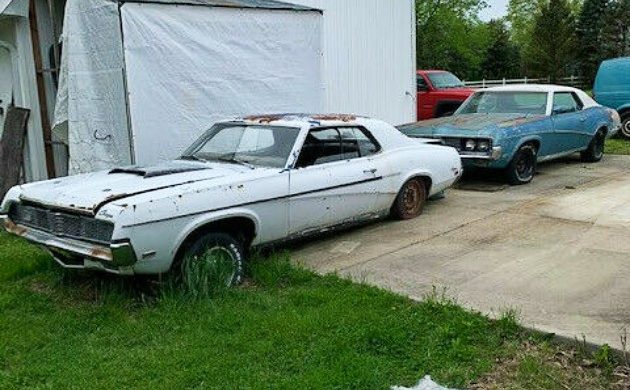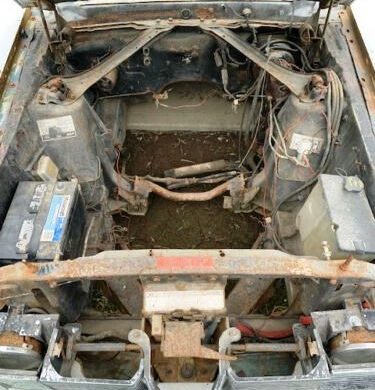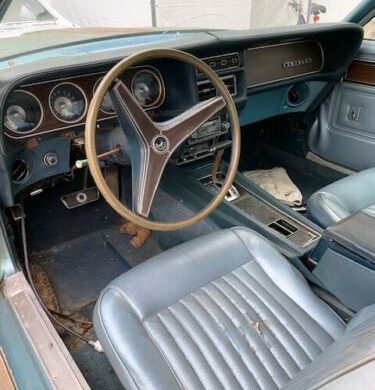Ironically, one of the most interesting 1969 Cougars came as a mid-year entry featuring an engine smaller in displacement than the standard 351 cid V8 shown in Mercury’s sales literature. April of 1969 saw Mercury roll out the sporty new Eliminator package, available with several engines including the heavy-hitting 428 cid Cobra Jet V8. This 1969 Mercury Cougar Eliminator in Carmel, Indiana came with what Mercury considered the top option, the Boss 302 engine, a lightweight and high-winding option developed for TransAm road racing. Appropriately, this Cougar also came with a four-speed manual transmission. Sadly the brilliant Boss 302 is “long-gone,” along with the original four-speed and 9″ rear end. The white roller comes with a date-correct four-speed and rear end. A blue donor car comes with the deal, matching the Eliminator’s original blue-blue color scheme. Despite these shortcomings, the package deal here on eBay has attracted at least 10 bidders and surpassed $9500.
A Marti report and original sales documents confirm the Eliminator package and Boss 302 engine. This package is more than a clever Marketing idea; Bud Moore Cougars with Dan Gurney and others at the wheel did well in the ’67 Trans Am series, nearly beating the Carroll Shelby Mustangs. Though slightly larger and more luxurious, the Cougar shared its platform with its Mustang sibling, so chassis and other racing parts interchange across both.
The donor car comes from California and ran “a few” years ago. The listing makes no mention of its engine, and some might question which car should be revived considering the Eliminator lacks its original powerplant. That said, Ford engines of this era did not come with VIN stamps so maybe a buyer with a date-code correct Boss 302 in the back corner of their garage will pull the trigger on this combo deal.
With power windows and what might be air conditioning ducts, the California donor car looks interesting itself. Sure; I’d rather own the non-original Eliminator, and a hot crate motor will reasonably replicate the Boss 302, but it seems a shame to chop up this intact and mostly rust-free donor. Like Mustangs, these 302-powered Cougar Eliminators feature prominently in the vintage road racing scene. What would you do with this twin-cat package deal?




I’ve always liked the Cougar that Mercury produced!! A friend of mine had a 69 convertible in high school!! The car was luxurious and still performed well!! The floor on the blue one looks pretty rusty and there’s no pictures of the white car at all!! The listing has more pictures of the rear spoiler and paper work then it has of the cars!!
Todd,
All 1969 Ford products will have the VIN stamped on the engine and transmission. It was required by federal law.
Hello CATHOUSE. It would be great if you can find a link to this federal law. I couldn’t find anything about it, but it does seem that the Boss 302 was stamped (see below). Very interesting! Thanks for your post. https://www.jacksonville.com/business/20180129/cars-we-remember-seasoned-collectors-explain-fords-numbers-matching-vehicles-or-lack-thereof and http://www.vintagethunderbirdclub.net/Tech%20Articles/matching_numbers.htm
I’m having a little trouble seeing updated posts for some reason, so this may be a duplicate, as I tried posting it earlier…
The Federal Law you are looking for is the National Traffic and Motor Vehicle Safety Act of 1966 (which went into effect 1 Jan, 1968).
https://uscode.house.gov/statutes/pl/89/563.pdf
It doesn’t come right out and state “ye olde engine and trans shall henceforth be stamped with thine VIN”. However, the gist of it is that the manufacturer has to be able to prove they / their components are in compliance with the Safety Act, and be able to issue recalls on components. This boiled down to requiring VIN stamps on the car body, as well as the engine and trans.
That “seasoned collector” states he focuses on Chevy’s, and had a 1965 T-bird that he couldn’t find a VIN stamp on… well, it was built before 1 Jan 1968… so I would be very suspicious if he did find a VIN-stamped block!
The Vintage T-Bird site article – remember, they are dealing with cars built during the heyday of the T-Bird – that is almost exclusively pre-1968.
That’s not exactly true, my ’69 Ford XL with the original 390 block does not have the VIN stamped anywhere on it. Date, part number, the “352” are of course all there. No VIN.
My `69 Mach 1 390ci, 4spd did have the VIN but you had to pull the engine to see it as it was on the back of the block.
Nowadays we have mirrors, and better yet, those cool bore-scope cameras to see into tight spots formerly tough to get to.
I enjoyed having a 69 XR7 for my first car. Of course being from Michigan the winter cancer really got to it. I have came across 2 cougar Eliminators in the past. One of which sat at an old farm. I wish I had a pocket full of cash then. I would definitely be fixing the eliminator first ! Maybe a modern 302 coyote engine.. no reason both of these can’t be fixed. The 69 body style is my favourite too.
Ford FE engines generally have the VIN stamped on the back of a head, not on the block. Have you checked for a stamping on your heads?
The heads have been changed out to 1964 heads, so there’s no way to verify that, unfortunately.
my first car while a Jr in high school was a comp orange 70 Eliminator, 351c car. I few yrs later I bought a 70 Boss Eliminator, Grabber Green, and have had a few cats since. One of my fav cars.
I have a 69Xr7 in the garage at the moment in the restoration process from top to bottom. These cars are somewhat rare as I’ve been told. Therefore the parts are hard to come by and very expensive when you do find them. So to come by a chance to get 2 and build 1 is a great opportunity.
There’s a cougar only salvage yard in California. The guy has been in here before with other cost postings.
This car has been featured on Barn Finds previously, back in Aug 2016.
http://barnfinds.com/rare-1969-mercury-cougar-eliminator-302
https://www.facebook.com/barnfinds/posts/1204642322911236
Good Eye/Good Memory!
I don’t see a final bid from that listing, but apparently we can assume that it did not sell. And, that the seller bought the parts car in the interim? EDIT: From the FB posts, it seems as though the 2016 auction ended at $9500. Things have not changed much in the last 4 years then?
This current auction has now ended with the old standby “This listing was ended by the seller because the item is no longer available.”
From what I can tell, the high bid was $9800, although one bidder had placed a proxy limit of $15000, and of course all were canceled. Maybe this car will be brought back to life. As car guys, we all hope so!
“Good Eye/Good Memory!”
Well, it doesn’t hurt that I track and document Eliminators for the Cougar Club of America and the Eliminator Registry ;-)
Seller spent the last few years gathering parts for the Eliminator, including the donor (which has a décor interior in the correct color – bonus!).
Just wait. In 2 years that’ll be a numbers-matched car with full documentation.
That’s why we have the Eliminator Registry, and Cougar Club of America. This car has already been documented and the info recorded with history going back several owners. Being a Boss 302, it’s also in the Boss 302 Registry. All a buyer has to do is contact the people who know these cars and their history. If a buyer gets had when purchasing any Eliminator it’s their own fault for not doing their due diligence.
My first car was a 68 Mercury Cougar with a 302 and three speed. It was fast and I loved the car so much. I think the donor car would be great restored and agree just throw a crate motor into the eliminator.
would still take a 69 mustang over this LOL